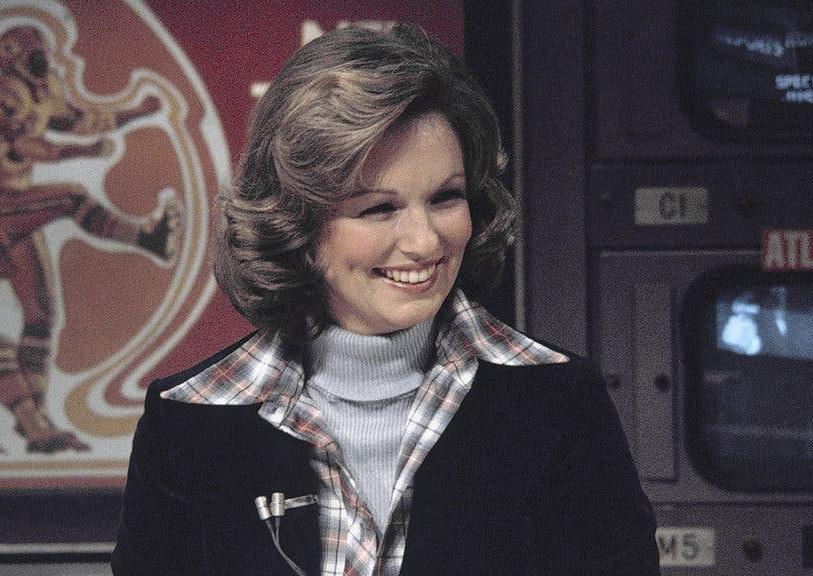
8 minute read
PHYLLIS GEORGE
Phyllis George was special. Her smile lit up millions of homes for the NFL Today. Folks — men and women — were comfortable with her talking about their favorite sport. And in New York, Philadelphia, and Washington, they loved Phyllis despite her Dallas Cowboys bias! – Brent Musburger, Sports Broadcasting Hall of Famer
Phyllis was a true pioneer for women in Sports. She was admired and loved by all of us who worked with her, not just for her talent, but for her warmth, kindness and a smile that lit up the TV screen. A true hall-offamer, who left us far too soon.”
– Bob Fishman, CBS and Sports Broadcasting Hall of Famer
She was Miss America. She was a co-host on Candid Camera. But it wasn’t until Phyllis George made the move to The NFL Today in 1975 that her popularity became apparent: her presence on the show made it appointment viewing,
The road to The NFL Today began in Denton, TX, a small town 42 miles north of Dallas. George’s parents were hardworking Methodist people, and, as a young girl, she watched the Miss America pageant with her mom every year.
“Back in the day, it was the biggest thing on television,” George told the University of Texas in 2018.
She rose to fame as Miss America, winning the crown in 1970. But, the year before, she placed second in the Miss Texas pageant and almost swore off competing the following year. “I came in second to a drummer from Longview,” she told Texas Monthly. “The local papers had to retrieve their original headline of ‘Miss Denton Becomes Miss Texas.’”
The Miss Dallas organization kept asking her to run for their title. She kept saying no but relented with the possibility of scholarship money as the carrot. Little did she know she would be named not only Miss Texas but also Miss America and be destined for a career in sports TV that ultimately would give her a chance to change the industry forever.
Being Miss America gave her a chance to be on arguably TV’s biggest stage: The Tonight Show With Johnny Carson. When she told Carson, “You’ll remember me. I’m the klutzy Miss America” (she dropped her crown while walking down the runway), viewers and the press were smitten, even though the concept of Miss America had its critics.
“The ‘women’s libbers’ — we didn’t call them ‘feminists’ — would follow me around,” she said. “I was in DeKalb, IL. I kept saying, ‘They’re not picketing me; they’re picketing what they think this program stands for.’ So I went outside and said, ‘It’s really cold out here. Why don’t you guys come in, and let’s have some coffee and talk about this?’
“They all came in,” she continued. “And I said, ‘Look, I don’t feel like I’m exploited. I’m from a small town in Texas. This is great for me. I won scholarship money. I’ve done something with my life, and I can show my talent. I want to be in broadcasting. This is going to help me, so I want you to look at it that way.’ Did I like being in a swimsuit? Absolutely not. I hated it.”
When she arrived in New York after her year as Miss America, she hoped to land a job in broadcasting. Making the rounds, she ran into two young producers from CBS Sports, Tommy O’Neill and Bob Stenner, and that meeting would soon prove important.
When the Miss America pageant invited her back to cohost with Bert Parks, it gave her a chance to be seen on TV, and, in 1974, Allen Funt hired her as a cohost for his Candid Camera show in New York. But working as the second banana to Funt wasn’t exactly what George had in mind when she sought a job in broadcasting.
Changes at CBS Sports at the end of the year offered an opportunity. President Bill MacPhail was quietly retired, and 38-year-old Bob Wussler was brought in.
A 13-week contract was drawn up with the promise that, if things worked out, it would
Sports Broadcasting Hall of Famer Lesley Visser (left) with George’s daughter, Pamela Brown
Phyllis was magic — warm and kind and authentic. She did stories that weren’t about the game but were about the people, and she did them as well as anyone ever has. Her legacy is that she didn’t just open the doors for other women, she rooted for them. It was in her DNA. – Lesley Visser, Sports Broadcasting Hall of Fame
She was the original natural. She was the most natural, open, delightful person and everyone adored her. She was the vanguard for women in televised sports and she didn’t break the mold; she was the mold. – Tommy O’Neill, NBC Sports
become permanent. “I accepted Bob Wussler’s offer,” George said, “partly because I needed a job — always a good incentive — and partly because something inside told me I could do it.” For one of her first assignments, she was sent to Boston to interview Celtics star Dave Cowens, who was never known for being glib. Cowens, who cherished his privacy and disliked interviews, had reluctantly agreed to the CBS request because the team management insisted it was good public relations. He also had no idea they were sending a woman. He took one look at her when she and her camera crew arrived at practice, according to George, and rolled his eyes.
“Hey, Dave, how are you?” she called out to him, but he didn’t respond. She tried again, and again he ignored her.
“As soon as practice was over, Cowens made a beeline for his Jeep,” George wrote in her memoir, Never Say Never. “I followed, and my producer urged me to hop in. I did.
She kept peppering him with questions on the 45-minute drive to his cabin, getting very few answers. When they got there, he took a beer out of the fridge, offered her one, which she declined, and they settled into a couple of rocking chairs on the porch. By the time the CBS crew arrived, she had slowly started to draw him out, and the interview turned into more of a conversation.
“He rocked back and forth in his old chair,” she wrote. “And he talked and talked. As the camera rolled, I instinctively tossed aside my formal questions and talked to him like a regular human being, not like a superstar. Mostly, I asked him what I was interested to know as a curious fan, questions like, ‘What would you do if it were all over tomorrow? Are there some days you just don’t want to suit up? What if you had an injury? Where would you go, what would you do? Do you ever want to settle down and get married?’”
These weren’t typical questions guys like Cowens were accustomed to hearing. Asking a player about his feelings was almost unheard of. When the piece got edited, it was obvious that George had captured a side of Dave Cowens that few people had ever seen. As she introduced the interview on the air, she said that Cowens had “a little bit of Huck Finn lingering inside him.”
Sports Broadcasting Hall of Famer and sportscaster Lesley Visser notes that Cowen didn’t warm up to that many people and that was part of George’s gift. “She was persistent and she was kind, so people wanted to embrace her and they rooted for her. She was someone that I think all of America fell in love with.”
Sports Illustrated’s Melissa Ludtke called it “probably the best national television piece ever done on [Cowen].” Ludtke should know: she was one of the very first women permitted to report from a pro locker room.
George had a straightforward philosophy for an interview: “I went for the heart, and the athletes gave heart back.”
Wussler later told USA Today that he knew all along she’d be great. “In my gut, I thought Phyllis was pretty special. I thought there was a role for her, as somebody who could talk to guys who knew something about sports.”
Her 13-week tryout quickly turned into a three-year deal, and George was on her way. A month later, she was starring on the hottest sports show on TV and, within a year, adorned the cover of People magazine.
“We all realized what we had [in Phyllis],” says Sports Broadcasting Hall of Famer Mike Pearl, who produced the show. “When we took the show on the road for the playoffs and Super Bowl, Phyllis was the main attraction. When we all walked through an airport or down a street together, the public would go to Phyllis. And when we went out for dinner, Phyllis was the one being asked for autographs.” – Ken Kerschbaumer

Thank you to Rich Podolsky for providing the majority of information in this bio from his book, “You Are Looking Live!”













